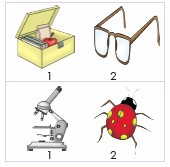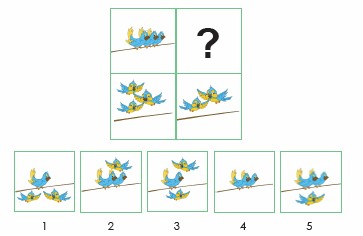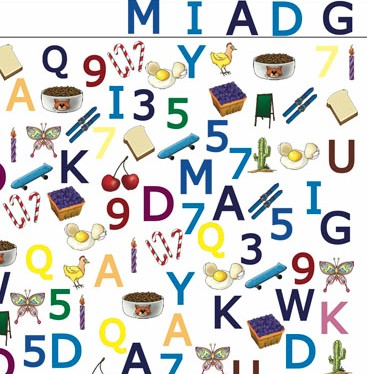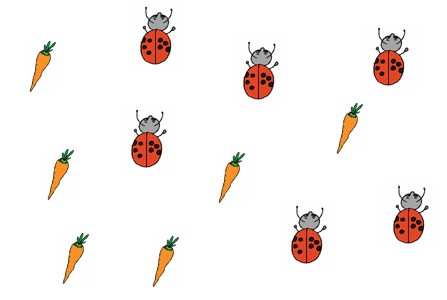The Wechsler Intelligence Scale for Children (WISC-IV) is an individually administered IQ test used with children aged from 6 to 16. Younger children are tested using the Wechsler Preschool and Primary Scale of Intelligence (WPPSI). Older children and adults are tested using the Wechsler Adult Intelligence Scale (WAIS). You can read more about the WISC-IV here. There are 15 subtests on the WISC-IV but they may not all be used. In addition to subtest scores a combined composite score is reported (the IQ). Composite scores relating to specific cognitive areas may also be reported (index scores can be produced in the areas of Verbal Comprehension, Perceptual Reasoning, Working Memory and Processing Speed.) Part of the WISC test protocol is to see how children will do when presented with questions of a type they haven't seen before. There is nothing on this page which is not publicly available information but we do not recommend that you attempt to familiarize your child with the content of the WISC using the information on this page or other sources. If your child is tested they will be given clear instructions and the testing will not proceed unless the tester believes that they understand what they are required to do. Any parent teaches their child and we look for quality resources to help us to do that. Most parents have no difficulty knowing how to teach their children the alphabet or how to count. Many parents have more difficulty knowing how to teach their children how to think. Finding out that their children will be taking a test like the WISC is often the first time they start to worry that they've missed something. Browsing the resources below should reassure you that your child has been exposed to the skills tested for on the WISC even if you weren't doing it consciously. If your child has areas of weakness you'd like to help them improve, or areas of strength where they would like access to enrichment material, the links below will help you find appropriate material.
Block Design
Block Design measures an individual’s ability to analyze and synthesize an abstract design and reproduce that design from colored plastic blocks. Spatial visualization and analysis, simultaneous processing, visual-motor coordination, dexterity, and nonverbal concept formation are involved. The students use logic and reasoning to successfully complete the items.
Block Design sub-test is a timed core Perceptual Reasoning sub-test.
Children are given bi-colored blocks and must arrange them to duplicate a printed image or modeled design.
Suggestions:
- Color Cubes (age 3 to adult. This classic toy is suitable for all ages. Each cube has four sides in a solid color and 2 sides which are bi-colored.)
- Pattern Block Activity Pack (age 5-11. A classic math manipulative used to encourage geometric exploration.)
-
-
Building Thinking Skills Figural Activities (the highest level in this series is called Building Thinking Skills Level 3 Figural. The lower levels contain Verbal activities in the first half of the book and Figural activities in the second half. Grade designations on these books are for average children and highly capable children can work well ahead)
-
Architect Series Games (age 6 to adult. A set of four books sold separately contain spatial visualization puzzles which are recreated with a specific set of geoblocks. Great fun for all ages.)
Similarities
Similarities measures logical thinking, verbal concept formation and verbal abstract reasoning. Two similar but different objects or concepts are presented, and the student is asked to tell how they are alike or different.
Similarities is an untimed core Verbal Comprehension sub-test.
Examples:
How are whales and lions similar?
How are anger and delight similar?
How are boys and girls similar?
Suggestions:
-
Building Thinking Skills Verbal Activities (the highest level in this series is called Building Thinking Skills Level 3 Verbal. The lower levels contain Verbal activities in the first half
of the book and Figural activities in the second half. Grade
designations on these books are for average children and highly capable
children can work well ahead)
-
Analogies titles like Think Analogies (we have analogy titles suitable for all ages and ability levels. Browse the sample pages and choose something that would be challenging without being frustrating)
- Nifty Fifty (publisher recommended for Gr 2-6 this title could also be used with an older child who has difficulty identifying the important attributes of objects and making connections. We recommend this title to all families as a dinner table discussion or fill the time in the car book.)
Digit Span
Digit Span measures short-term auditory memory and attention. The digits have no logical relationship to each other and are presented in random order by the examiner. The student must then recite the digits correctly by recalling them in the same order. On the second part of this subtest the student must remember the order in which digits are presented, but recite them in reverse order.
Digit Span is an untimed core Working Memory subtest.
Examples:
For Digit Span forward tester would read numbers like "2, 3, 9, 1"
and child would respond with the same numbers
For Digit Span backward the tester would read numbers like "24, 3, 7, 12"
and child would respond "12, 7, 3, 24"
Suggestions:
-
-
Memory Challenge (visualization of numbers as chunks can help memory of auditory information)
Picture Concepts
Picture Concepts measures categorical, abstract reasoning. Students are asked to look at two (or three) rows of pictured objects and indicate (by pointing) the single picture from each row that shares a characteristic in common with the single picture(s) from the other row(s).
Picture Concepts is an untimed core Perceptual Reasoning Subtest.
Example:
|
Pick one picture from each
row that go together
|

|
Coding
Coding measures visual-motor dexterity, associative nonverbal learning, and nonverbal short-term memory. Fine-motor dexterity, speed, accuracy and ability to manipulate a pencil contribute to task success; perceptual organization is also important.
Coding is a timed core Processing Speed subtest.
For children aged 6-7 the test is picture based. Children are given a worksheet like the example below. The first line contains the key. They must place a mark within all the other figures so that they match the key.
For children aged 8-16 the key consists of boxes containing a numeral in the top line and a symbol in the bottom line. They must write the symbol corresponding to each numeral in the worksheet provided.
Suggestions:
Vocabulary
Vocabulary measures the students’ verbal fluency and concept formation, word knowledge, and word usage.
Vocabulary is an untimed core Verbal subtest
Example:
Children are shown pictures or a word is said aloud. They are asked to provide the name of the object or to define the word.
|
What is this?
|

|
What does simple mean?
Suggestions:
-
Word Roots (Formal vocabulary study with Greek and Latin root words, prefixes and suffixes. Choose from books, software or flashcards to learn from. Suitable for use from Gr 3 and up)
-
Vocabulary Cartoons (Informal vocabulary study made fun with visual mnemonics for words every student should know. Suitable for use from about Gr 3 up to SAT vocabulary level.)
Letter-Number Sequencing
Letter-Number Sequencing measures attention span, short-term auditory recall, processing speed and sequencing abilities. The task involves listening to and remembering a string of digits and letters read aloud at a speed of one per second, then recalling the information by repeating the numbers in chronological order, followed by the letters in alphabetical order. Letter- Number Sequencing is an untimed core Working Memory subtest. Example: A - 7 - X - 2 - M - 4 Response: 2, 4, 7, A, M, X Suggestions:
- Look! Listen! Think!
- Memory Challenge (visualization the information as it is read can aid recall)
- Number Patterns
Matrix Reasoning
Matrix Reasoning measures visual processing and abstract, spatial perception and may be influenced by concentration, attention, and persistence.
Matrix Reasoning is an untimed core Perceptual Reasoning subtest.
Children are shown colored matrices or visual patterns with something missing. The child is asked to select the missing piece from a range of options.

Suggestions:
-
Building Thinking Skills
-
Math Analogies
-
Visual Discrimination
-
Look! Listen! Hear!
-
Number Patterns
-
MiniLUK
Comprehension
Comprehension measures common-sense social knowledge, practical judgment in social situations, and level of social maturation, along with the extent of development of their moral conscience. Children are asked to explain situations, actions, or activities that they'd be expected to be familiar with.
Comprehension is a core Verbal Comprehension subtest.
Example: Why do we turn out lights when we leave a room?
Suggestions:
-
What Would You Do?
-
Nifty Fifty
Symbol Search
Symbol Search requires the student to determine whether a target symbol appears among the symbols shown in a search group. Memory is not a primary requirement for success on this task; perception and recognition are the two prime requirements, in addition to speed, accuracy, attention, and concentration. The symbols are geometric forms, rather than familiar letters or numbers.
Symbol Search is a timed core Processing Speed subtest
Suggestions:
Picture Completion
Picture Completion measures a student's ability to recognize familiar items and to identify missing parts. The student's task is to separate essential and nonessential parts from the whole. It is necessary to observe each item closely and concentrate on picture detail. Students must name or indicate the missing part by saying the name of the part or by pointing to it.
Picture Completion is a timed supplemental Perceptual Reasoning subtest

Suggestions:
-
Thinker Doodles
-
Dot-to-Dots
-
Visual Discrimination
-
Look! Listen! Hear!
Cancellation
Cancellation measures visual vigilance/neglect, selective attention, and speed in processing visual information in accordance with previous attempts along the same line.
Cancellation is a timed supplemental Processing Speed subtest
Children scan a two-page spread of relatively small colorful pictures. The pictures include animals and objects and the child's task is to identify all the appearances of the target animal. The illustration below shows a similar type of exercises where the child's role is to identify target letters amongst the clutter.

Suggestions:
-
Visual Discrimination
-
Building Thinking Skills
-
Dot-to-Dot
(And look on your home bookshelf for classics like I Spy and Where's Waldo?)
Information
Information measures general cultural knowledge, long-term memory, and acquired facts. Children are asked questions about different topics like geography, science and historical figures. The questions shouldn't be difficult for a child with a well rounded education but they do encompass a wide range of knowledge.
Information is a supplemental Verbal Comprehension subtest.
Example: Who was Queen Elizabeth I
Example: What do your lungs do?
Example: What is photosynthesis?
Suggestions: The focus of our store is thinking skills material rather than general knowledge. We suggest you encourage your child to read quality non-fiction and help them make links between what they're studying at school now and what they've studied in the past so that they retain information. The titles below can be used to check that your child has the expected grade level knowledge and to build general knowledge:
-
Daily Mind Builders
- What Do You Know?
Arithmetic
Arithmetic measures numerical accuracy, reasoning and mental arithmetic ability. Mental arithmetic and story problems play an important part in the student’s success.
Arithmetic is a supplemental Working Memory subtest.
Example: How many carrots are there in this picture?

Example: Michelle is 2 years younger than Peter and 5 years older than Sam. If Sam is 6 how old is Michelle?
Example: Kathy's lunch bill was $22.50. If she leaves a 15% tip how much money does she need to leave?
Suggestions:
-
180 Days of Math
-
Math Word Problems
Word Reasoning
Word Reasoning measures verbal abstract reasoning requiring analogical and categorical thinking, as well as verbal concept formation and expression.
Word Reasoning is a supplemental Verbal Comprehension subtest.
Children are asked to identify the object described by clues they're given.
Example: An item of clothing which you sleep in.
Suggestions:
-
Building Thinking Skills
-
Analogies
|